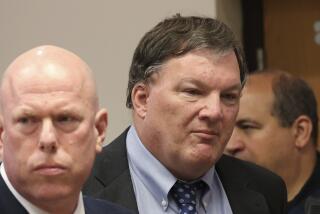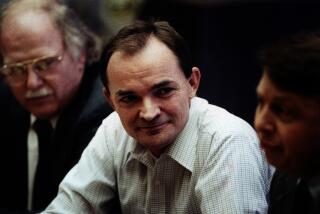Debate Set on What Prosecution Labels Kraft ‘Death List’
- Share via
Randy Steven Kraft’s attorneys on Friday argued that a piece of paper found in his car--which prosecutors claim is Kraft’s own list of his murder victims--should be barred from his murder trial unless the prosecution can prove that it is an actual death list.
Kraft attorney William J. Kopeny told Superior Court Judge Donald A. McCartin that the list is a critical issue because sealed prosecution papers indicate “it will be the focal point of the prosecutor’s closing argument.”
Hearing Tuesday
McCartin scheduled a hearing Tuesday to debate the admissibility of the list.
Kraft, 43, is charged with 16 Orange County murders. He is also accused by prosecutors of another 21 murders that they plan to introduce if his trial reaches a death penalty hearing. No defendant in California has ever been accused in court of that many murders.
After five years of delay, Kraft’s trial began with jury selection in McCartin’s Santa Ana courtroom in early July. A jury was finally picked on Wednesday and testimony is scheduled to begin Sept. 26. The judge has warned jurors that the trial could take up to a year.
Two of the jurors--one regular and one alternate--have since pleaded hardship and asked to be excused. The judge said he will decide on their requests next week.
List Has Over 60 Entries
Prosecutors claim that 14 of the 16 murders with which Kraft is charged--plus an undisclosed number of the other 21 alleged murders--can be linked to Kraft through the handwritten list found in the trunk of his car when he was arrested in May, 1983. The list, which has been sealed from the public by court order, includes more than 60 entries, according to court documents.
“The items on the list at first blush may not make any sense; but when you put them together, along with other facts in the case, it is very clear that this is a death list,” Deputy Dist. Atty. Thomas M. Goethals said after the hearing.
Kraft attorneys have made several previous attempts to have the list barred, but each time a judge has ruled against them. On Friday, the defense offered a five-point argument against the list:
- The prosecution has failed to prove that it is a death list and not a list of something else.
- The prosecution should not be allowed to introduce any entries on the list that it cannot connect to a known victim. Prosecutors have admitted that they cannot explain every item on the list.
- The list is inadmissible hearsay, since prosecutors are trying to use the list to tell jurors that Kraft is, in effect, “confessing” to murders through the list.
- The list is “highly prejudicial” because jurors might read into it a meaning that the defendant never intended.
- Prosecutors should not be able to introduce the list unless they can produce an expert witness who can authenticate it as a death list.
“Our contention is that the list is meaningless,” Kopeny said after the hearing. “But it’s obvious that this is going to be the central piece of evidence used against our client.”
On May 14, 1983, Kraft was arrested on the San Diego Freeway in Mission Viejo by two California Highway Patrol officers who found a dead Marine in the passenger seat of Kraft’s vehicle. The victim, Terry Lee Gambrel, had been drugged and strangled with his own belt.
Gambrel, who represents the first of the 16 murder charges filed against Kraft, is not on the list, but only because Kraft did not have time to put him there, prosecutors contend. Some items from the list have been made public, including those that prosecutors link to 12 of the 16 murders with which Kraft has been charged. For example:
Prosecutors claim that the notation “EDM” from the list stands for Edward Daniel Moore, 20, whose body was found Dec. 26, 1972. “Jail Out” from the list, they claim, stands for Roland Gerald Young, 23, whose body was found June 11, 1978. Young had just been released from the Orange County Jail a few hours before his body was found. “Parking Lot” from the list, prosecutors claim, stands for Keith Daven Crotwell, 19, found dead on May 8, 1975. He was last seen leaving the Belmont Plaza parking lot in Long Beach with Kraft in Kraft’s car.
Three others, other than Gambrel, among the 16 murder charges have not been publicly connected to the Kraft list by prosecutors. But Judge McCartin said from the bench Friday that only one besides Gambrel is not linked to the list by prosecutors.
Prosecutors had made a proposal that they believed would satisfy the defense: that they would not let jurors know about the list until near the end of the trial. Then the judge could hold a hearing outside the jury’s presence to determine whether the prosecution had laid the proper foundation for the list’s admissibility.
But defense attorneys rejected that plan. Kopeny said they did not want to begin cross-examining witnesses until they knew where they stood on the list.
“Frankly, I’m surprised,” Goethals said later. He explained that his offer would have meant that Deputy Dist. Atty. Bryan F. Brown, the trial prosecutor, would not even bring up the list in his opening statement to the jury.
“The way the defense wants it, it seems to me we will be free to put that list smack out in front of the jury right away,” Goethals said.
In other developments Friday in the Kraft murder case:
- Judge McCartin rejected a last-minute defense request that the trial be moved to a different county because of heavy pretrial publicity.
The judge said it was not even a close call.
“Quite frankly, gentleman, I’m amazed at how little the jurors really did know about this case,” McCartin said.
- The judge said he may decide to make public the Kraft list and other sealed documents related to the list after the hearing next Tuesday.
- The judge announced that Hughes Aircraft Corp., the employer of one of the jurors seeking to be excused, refused to change its position not to pay the employee his salary for the full length of the trial. But the judge said that company officials did agree to advance the employee his own vacation time from future years.
More to Read
Sign up for Essential California
The most important California stories and recommendations in your inbox every morning.
You may occasionally receive promotional content from the Los Angeles Times.









